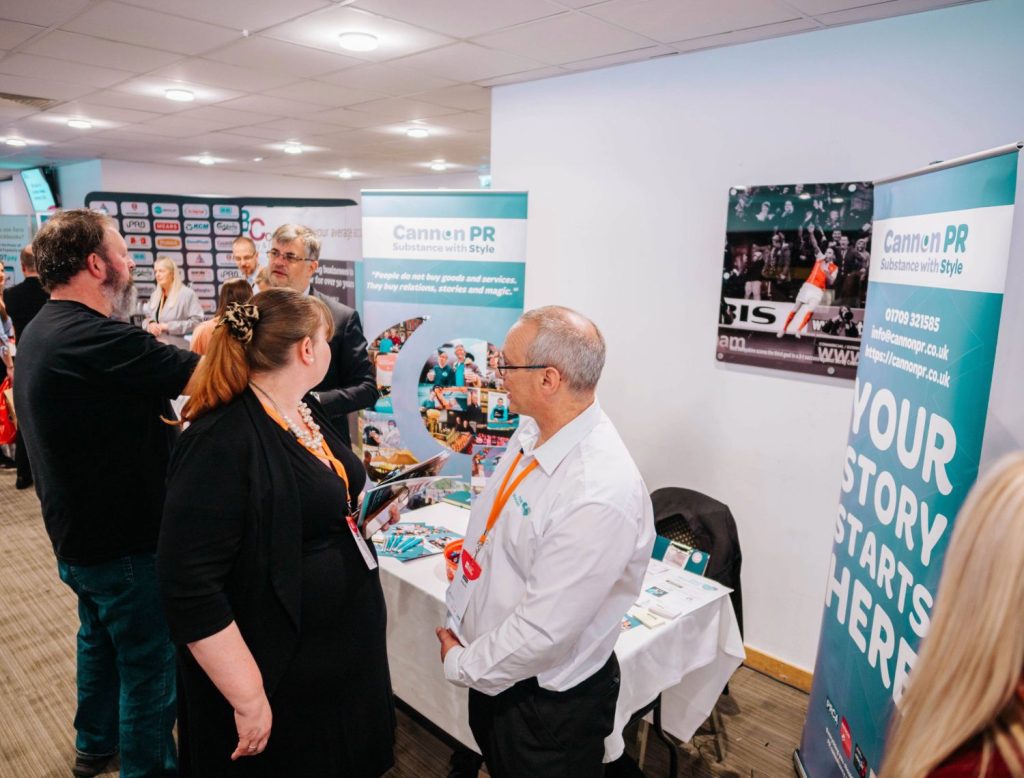Forget the free pens, become a business show expert in three simple steps

If the highlight of your business show experience is leaving with a load of free pens and the gin draw filled you with indifference, you’re not alone. Business exhibitions can be a highly effective way of making new business connections as well as increasing brand visibility and profile, but to achieve that, your business needs a plan.
From a PR perspective, business events are an incredibly powerful tool, particularly when it comes to connecting and engaging with others. The way they are used as part of a PR strategy can be incredibly diverse: from creative, carefully developed stunts specifically designed to raise eyebrows and set tongues wagging, to maximising opportunities offered by product launches, discussion panels, awards and exhibitions, to name but a few.
However, today we’re going to look specifically at business shows and how to make the most of them.
Exhibiting at a business show is much more than simply turning up with a roller banner and an armful of promotional pens, waiting for the magic to happen. It requires a plan.
If you’re considering exhibiting at a business show or you’ve booked your spot and are unsure what to do next, this guide is for you.
Step 1: Preparation:
- Set a clear goal
An event isn’t just a financial commitment; it’s also a significant time investment. From the outset, spend some time setting your goals and what you would like to achieve from the day.
Businesses use business exhibitions in lots of different ways: generating new business leads and building brand awareness are often the most common reasons for attending a show, but others use them as a way of gathering market data and forging partnerships, and they are even used as a recruiting tool. Whatever the reason you choose to take part in a business show, having a clear goal will help you define what success looks like and the steps you need to take to achieve it.
- Understand your audience
A common mistake many businesses make is assuming that simply because they have booked a stand at a business show, everyone in the room is automatically a prospective customer.
Spend time understanding who you would like to reach and perhaps equally importantly, what you want to communicate.
- Make a stand!
You’ve got your plans in place, and now it’s time to put them into action. Your exhibition stand will be the first impression delegates will have of your business. At a busy show with hundreds of businesses clamouring for your attention, your business needs to stand out, for the right reasons.
When planning your stand design, give thought to how your space will attract attention and what steps you can take to encourage engagement. For example, one tried and tested technique is to consider running a skill-based competition, whereas a prize draw can be an effective way of collecting business cards.
An all-too common mistake can be to simply fill the empty space with as much promotional merchandise as you can lay your hands on. Think about how you can integrate technology into your offering, and if appropriate, consider live demonstrations or interactive elements to keep people engaged and spark conversations.
- Grabbing attention
The show doesn’t start when the doors open – your strategy should begin several weeks ahead of the big day. One of the most effective ways of doing this is to encourage businesses that you would like to engage with to take part in the day.
Social media can be an effective way of building a buzz about what visitors to your stand can expect. Don’t forget to share information to your email contacts, and, if you’re doing something extra special, think about using a press release to build awareness both online and offline.
- Prepare your team
First impressions count. It doesn’t matter how impressive your stand looks if that isn’t borne out by the people representing your business. Make sure your team are fully up to date with the products and services your business delivers, but enthusiasm and attitude really matter.
Spend time preparing for the questions you are likely to be asked about your business and think about how you can convey what your business does, who it helps and what makes it unique in a short, succinct and engaging way. Finally, don’t forget to test any equipment you are relying on during the day!
Step 2: Showtime!
- Arrive early
Give yourself plenty of time to set up your stand, test equipment and make sure that everything is ready to go by the time the doors open. Rushing in at the last minute can mean finer details get missed and can scupper your preparation time. Once you’ve set up, make sure that your team is briefed and fully prepared before the doors open.
- Be approachable
There can be nothing more likely to encourage a visitor to move on to the next stand than someone sitting behind a desk, fiddling on their phone! Don’t wait for visitors to come up to you and start conversations, make eye contact, greet them and don’t be afraid to strike up conversations. You’ll never quite know where they will lead!
- Incentivise visitors
Creating a reason to act immediately can encourage action. If appropriate, consider an exclusive offer for delegates, a free trial or a promotional giveaway. Be sure to promote the offer throughout the day and as part of your pre-show preparations.
- Record and qualify potential leads
During the day, it’s likely that you will have conversations with lots of different people, and if you’ve prepared correctly, it’s probable that by the end of the day, you’ll have met some people interested to know more about your products and services. Take notes of any follow-up actions you have agreed.
- Enjoy the show!
It’s not uncommon for business shows to provide a range of different activities throughout the day. Attending talks and dedicated networking events can provide invaluable opportunities to make new business contacts. Don’t forget to make time to explore the show and introduce yourself to others exhibiting there.
Now the show has ended, it’s time for the hard work to begin…
Step 3: Next steps
- Follow up promptly
After the doors have closed, it’s important to follow up on the conversations you had whilst the event is still fresh in the minds of the people you’ve met. Follow up promptly with any agreed actions discussed during the event.
- Debrief
Meet with your team as soon as possible to understand their thoughts about how the day went. Capture feedback whilst it’s still fresh in your mind and discuss what worked well, what could be improved and their views on how the day went from their perspective.
- Evaluate
When evaluating the overall effectiveness of the event, give thought to the following questions:
- Would we support this event again?
- What worked well?
- What would we change?
Compare how your event performed with your initial goals and continue to track and monitor your outcomes over the following weeks or months. This information can be useful when it comes to calculating your return on investment.
With the right preparation, execution and follow up actions, a business show can deliver much more than the feel-good factor on the day, it can act as a catalyst to drive real business growth – and at Cannon PR we’re here to support you on every step of your business journey. Find out more about our PR services here.
